From the Trenches
A Major New Venue
By KATE RAVILIOUS
Monday, April 08, 2013
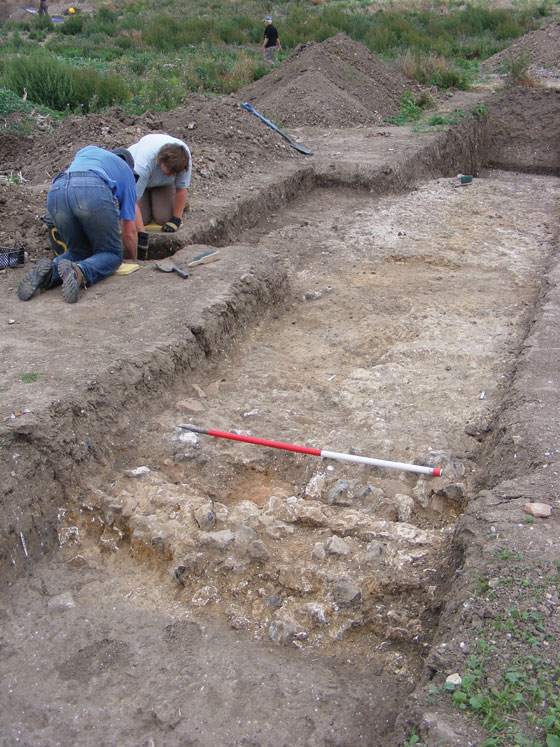 Outdoor Roman theaters are common in northwest Europe, but strangely absent from the British Isles. Now, a 2,000-year-old theater has been uncovered, cut into a hillside in southeast England.
Outdoor Roman theaters are common in northwest Europe, but strangely absent from the British Isles. Now, a 2,000-year-old theater has been uncovered, cut into a hillside in southeast England.
Up to 12,000 people could sit in a semicircle of 50 rows of seats. Below was an orchestra pit and a narrow stage, featuring holes that may have allowed the stage to be flooded for aquatic displays such as naval battles. “It was like a spiritual form of the Glastonbury Festival, where people congregated to feast, fair, and communicate with the gods,” says Paul Wilkinson, director of the Kent Archaeological Field School.
The theater overlooks sacred freshwater springs, where inscribed rolls of lead were found which, perhaps, were requests to the gods. Foundations of two temple-like structures, with fragments of a fine, colored mosaic floor, confirm the site’s important sanctuary status. So why aren’t there more Roman theaters in Britain? “I think we just haven’t spotted them yet,” says Wilkinson.
Thracian Treasure Chest
By MATTHEW BRUNWASSER
Monday, April 08, 2013
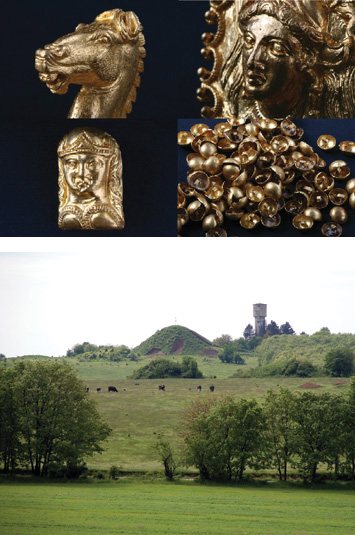 "The Thracians are the most powerful people in the world, except, of course, for the Indians,” wrote the fifth-century B.C. Greek historian Herodotus. In citing the Thracians, he was referring to the group of tribes who inhabited a large part of the Balkans and parts of Western Anatolia—from the Aegean to the Carpathian Mountains, and as far as the Caucasus—from approximately the twelfth century B.C. to the sixth century A.D. Despite their fearsome reputation, relatively little is known about them. Few examples of their writing survive, and what other information we have comes from Greek literary sources and Thracian burial mounds. Many of these mounds have been excavated since the end of the Cold War, when their former lands, Bulgaria and Romania in particular, became accessible to well-trained archaeologists and modern methodology.
"The Thracians are the most powerful people in the world, except, of course, for the Indians,” wrote the fifth-century B.C. Greek historian Herodotus. In citing the Thracians, he was referring to the group of tribes who inhabited a large part of the Balkans and parts of Western Anatolia—from the Aegean to the Carpathian Mountains, and as far as the Caucasus—from approximately the twelfth century B.C. to the sixth century A.D. Despite their fearsome reputation, relatively little is known about them. Few examples of their writing survive, and what other information we have comes from Greek literary sources and Thracian burial mounds. Many of these mounds have been excavated since the end of the Cold War, when their former lands, Bulgaria and Romania in particular, became accessible to well-trained archaeologists and modern methodology.
This past November, archaeologist Diana Gergova of the National Institute of Archaeology at the Bulgarian Academy of Sciences entered the burial chamber of an almost 60-foot-tall mound in the Sveshtari necropolis, some 250 miles northeast of the Bulgarian capital of Sofia. There she discovered a wooden chest filled with hundreds of gold artifacts. Gergova believes that the burial belonged to a ruler of the Getae, one of the most powerful of the Thracian tribes, who, around 2,400 years ago, were “at their absolute height, politically, culturally, and militarily.”
According to Gergova, the finely crafted gold treasures from Sveshtari help confirm the ancient writers’ accounts of Thracian culture. The craftsmanship also reveals previously unknown stylistic connections to other tribes in the northern and western regions of the Black Sea, providing evidence for a wide cultural ring across Thracian lands. The site could also provide new insight into the Thracian religion, including their belief in the immortal nature of the human soul, which may have influenced early Christianity, says Gergova. “These finds have given us an incredible amount of information about the burial and post-burial practices of the northern Thracians.”
A Pyramid Fit for a Vizier
By NIKHIL SWAMINATHAN
Tuesday, April 30, 2013
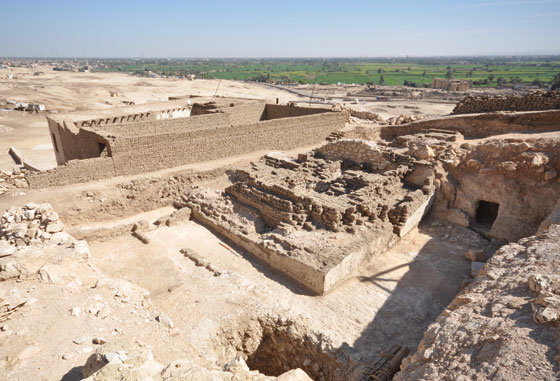 Belgian archaeologists recently uncovered a mudbrick structure on a hill at Thebes (modern Luxor) that is actually the base of a pyramid erected for a top minister of 19th Dynasty pharaoh Ramesses II, who ruled Egypt from 1279 to 1213 B.C. Bricks from it are stamped with a rectangular hieroglyphic inscription,“Osiris, the vizier of Upper and Lower Egypt, Khay.” The minister, Khay, who is buried in a tomb beneath the pyramid, can be seen in the structure’s capstone, which pays respect to Re-Horakhty, a combination of the sun god Re and sky god Horus. The pyramid would have measured 40 feet along each side, stood roughly 50 feet tall, and overlooked Ramesses II’s funerary temple.
Belgian archaeologists recently uncovered a mudbrick structure on a hill at Thebes (modern Luxor) that is actually the base of a pyramid erected for a top minister of 19th Dynasty pharaoh Ramesses II, who ruled Egypt from 1279 to 1213 B.C. Bricks from it are stamped with a rectangular hieroglyphic inscription,“Osiris, the vizier of Upper and Lower Egypt, Khay.” The minister, Khay, who is buried in a tomb beneath the pyramid, can be seen in the structure’s capstone, which pays respect to Re-Horakhty, a combination of the sun god Re and sky god Horus. The pyramid would have measured 40 feet along each side, stood roughly 50 feet tall, and overlooked Ramesses II’s funerary temple.
Multiple waves of settlements helped keep the pyramid hidden. Laurent Bavay, an archaeologist at the Université libre de Bruxelles, notes that parts of the monument were used to construct Coptic hermitages atop the site more than 1,300 years ago. Then, in the nineteeenth century, Egyptians arrived at the Theban necropolis to hunt for antiquities they could sell to Europeans. “They literally settled on the tombs to plunder them, systematically,” he explains. The exact location of Khay’s tomb is under one of the remaining local residences, to which the archaeologists do not currently have access.
Second to Whom?
By JARRETT A. LOBELL
Tuesday, April 30, 2013
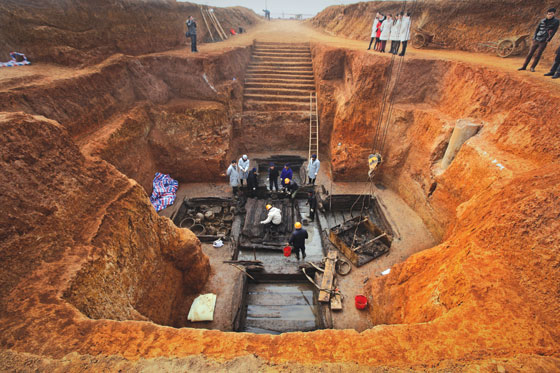 Over the past three years, archaeologists working at an ancient necropolis outside the city of Suizhou in southern China’s Sichuan Province have excavated 65 tombs. But according to excavation director Huang Fengchun of the Hubei Provincial Institute of Cultural Relics and Archaeology, tomb 18 in particular is “quite special.” The shape of the tomb resembles the ancient form of the Chinese character “Ya,” which means “second” or “inferior.” The quality of the grave goods found in the tomb, including numerous precious bronze vessels, indicates it likely belonged to a state official of the eastern Zhou Dynasty (770–256 B.C.). But exactly what or whom he was second or inferior to is unknown. Perhaps the answer lies in a 66th tomb.
Over the past three years, archaeologists working at an ancient necropolis outside the city of Suizhou in southern China’s Sichuan Province have excavated 65 tombs. But according to excavation director Huang Fengchun of the Hubei Provincial Institute of Cultural Relics and Archaeology, tomb 18 in particular is “quite special.” The shape of the tomb resembles the ancient form of the Chinese character “Ya,” which means “second” or “inferior.” The quality of the grave goods found in the tomb, including numerous precious bronze vessels, indicates it likely belonged to a state official of the eastern Zhou Dynasty (770–256 B.C.). But exactly what or whom he was second or inferior to is unknown. Perhaps the answer lies in a 66th tomb.
Europe's First Farmers
By KATHERINE SHARPE
Tuesday, April 30, 2013
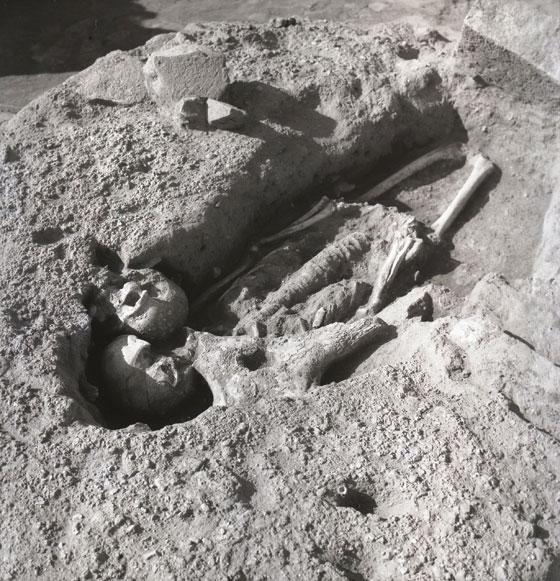 Thousands of years ago, the steep geologic folds of the Danube Gorges region, in present-day Romania and Serbia, were lushly forested and filled with game. The Danube River itself teemed with fish. It was an ideal home for the foragers who had lived there for millennia.
Thousands of years ago, the steep geologic folds of the Danube Gorges region, in present-day Romania and Serbia, were lushly forested and filled with game. The Danube River itself teemed with fish. It was an ideal home for the foragers who had lived there for millennia.
But around 6200 B.C., foreigners began appearing. They came from the south and east, and hailed from farming communities, says anthropologist T. Douglas Price of the University of Wisconsin–Madison. Price recently analyzed strontium isotopes in 153 sets of human teeth from ancient burials in the Gorges. Strontium, which is present in the environment and becomes a permanent part of our tooth enamel in childhood, leaves a distinctive signature that lets scientists pinpoint an individual’s place of origin.
The technique allowed Price and Dušan Borić, of Cardiff University, to document an influx of farmers into the area, including a number of women, who may have married into foraging groups. The work helps settle a decades-old debate about whether farming was brought to Europe by colonizers or diffused from community to community. “In Southeastern Europe,” Price says, “the colonization model is what’s going on.”
Advertisement
Advertisement
IN THIS ISSUE
Features
On the Trail of the Mimbres
Haunt of the Resurrection Men
The Kings of Kent
Letter from Turkey
From the Trenches
Albanian Fresco Fiasco
Off The Grid
Visions of Valhalla
Archaic Engineers Worked on a Deadline
Europe's First Farmers
A Pyramid Fit for a Vizier
Second to Whom?
Thracian Treasure Chest
A Major New Venue
A Killer Bacterium Expands Its Legacy
Bad Monks at St. Stephen's
Hail to the Bождь (Chieftain)
Oops! Down the Drain
From Egyptian Blue to Infrared
Advertisement

Recent Issues
-
 May/June 2024
May/June 2024
-
 March/April 2024
March/April 2024
-
 January/February 2024
January/February 2024
-
 November/December 2023
November/December 2023
-
 September/October 2023
September/October 2023
-
 July/August 2023
July/August 2023
-
 May/June 2023
May/June 2023
-
 March/April 2023
March/April 2023
-
 January/February 2023
January/February 2023
-
 November/December 2022
November/December 2022
-
 September/October 2022
September/October 2022
-
 July/August 2022
July/August 2022
-
 May/June 2022
May/June 2022
-
 March/April 2022
March/April 2022
-
 January/February 2022
January/February 2022
-
 November/December 2021
November/December 2021
-
 September/October 2021
September/October 2021
-
 July/August 2021
July/August 2021
-
 May/June 2021
May/June 2021
-
 March/April 2021
March/April 2021
-
 January/February 2021
January/February 2021
-
 November/December 2020
November/December 2020
-
 September/October 2020
September/October 2020
-
 July/August 2020
July/August 2020
-
 May/June 2020
May/June 2020
-
 March/April 2020
March/April 2020
-
 January/February 2020
January/February 2020
-
 November/December 2019
November/December 2019
-
 September/October 2019
September/October 2019
-
 July/August 2019
July/August 2019
-
 May/June 2019
May/June 2019
-
 March/April 2019
March/April 2019
-
 January/February 2019
January/February 2019
-
 November/December 2018
November/December 2018
-
 September/October 2018
September/October 2018
-
 July/August 2018
July/August 2018
-
 May/June 2018
May/June 2018
-
 March/April 2018
March/April 2018
-
 January/February 2018
January/February 2018
-
 November/December 2017
November/December 2017
-
 September/October 2017
September/October 2017
-
 July/August 2017
July/August 2017
-
 May/June 2017
May/June 2017
-
 March/April 2017
March/April 2017
-
 January/February 2017
January/February 2017
-
 November/December 2016
November/December 2016
-
 September/October 2016
September/October 2016
-
 July/August 2016
July/August 2016
-
 May/June 2016
May/June 2016
-
 March/April 2016
March/April 2016
-
 January/February 2016
January/February 2016
-
 November/December 2015
November/December 2015
-
 September/October 2015
September/October 2015
-
 July/August 2015
July/August 2015
-
 May/June 2015
May/June 2015
-
 March/April 2015
March/April 2015
-
 January/February 2015
January/February 2015
-
 November/December 2014
November/December 2014
-
 September/October 2014
September/October 2014
-
 July/August 2014
July/August 2014
-
 May/June 2014
May/June 2014
-
 March/April 2014
March/April 2014
-
 January/February 2014
January/February 2014
-
 November/December 2013
November/December 2013
-
 September/October 2013
September/October 2013
-
 July/August 2013
July/August 2013
-
 May/June 2013
May/June 2013
-
 March/April 2013
March/April 2013
-
 January/February 2013
January/February 2013
-
 November/December 2012
November/December 2012
-
 September/October 2012
September/October 2012
-
 July/August 2012
July/August 2012
-
 May/June 2012
May/June 2012
-
 March/April 2012
March/April 2012
-
 January/February 2012
January/February 2012
-
 November/December 2011
November/December 2011
-
 September/October 2011
September/October 2011
-
 July/August 2011
July/August 2011
-
 May/June 2011
May/June 2011
-
 March/April 2011
March/April 2011
-
 January/February 2011
January/February 2011
Advertisement






